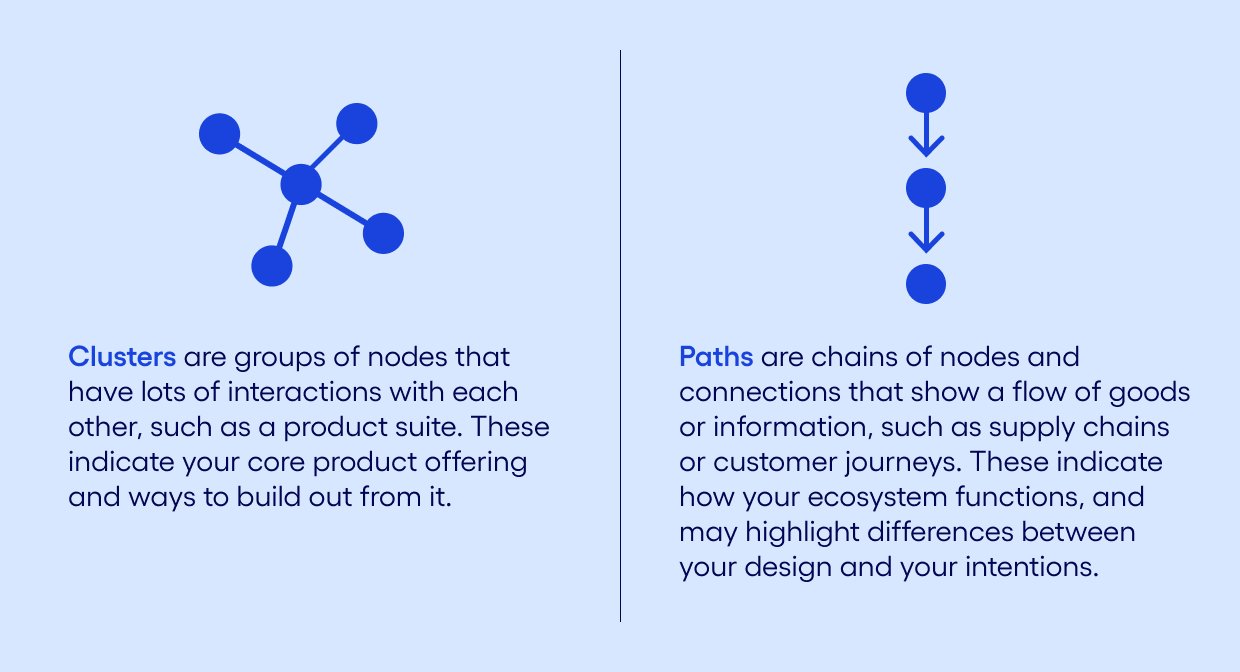At a certain stage of growth, great products will no longer be enough to differentiate your brand, and you’ll have to shift your thinking from standalone products to how different products and businesses interact within your market. Using an ecosystem map, you can visualize these interactions geometrically to help shape a holistic product strategy. Here’s how to understand, develop, and manage your own product ecosystem effectively.
What is a product ecosystem?
In biology, an ecosystem is a dynamic system of interactions between living organisms and their nonliving physical environment.
A product ecosystem is a business strategy that seeks to create additional customer value through product interactions. Companies that pursue a product ecosystem design their products to integrate with and complement one another, so that customers have most or all of their needs met by one provider.
What are the benefits of creating a product ecosystem?
Compared to a standalone product strategy, which focuses on the value of each product, an ecosystem strategy focuses on the added value of product interactions.
- For customers, each of your offerings—and especially your focal product—will be more valuable because they’ll be designed with integration and cross-product customer journeys in mind.
- For your business, mapping your product ecosystem will help you to understand the mechanisms driving your growth, simplify customer experiences, and identify potential directions to innovate in.
Is a product ecosystem strategy right for you?
Deciding if you’re ready to pursue a product ecosystem depends on your stage of business growth.
If you’re a small- or medium-sized business looking to remain competitive in a crowded market, the return from standalone products may taper off, and you’ll need to create an ecosystem of integrated products.
If you’re in the startup phase, it’s usually best to release standalone products that supplement the existing customer and competitor landscape. You’ll have less control over the whole system, but you can gather valuable insights on how ecosystems react to pressures like supply chain disruptions, ecological disasters, or economic downturns. Once you’ve built up your offerings, use these observations to fortify your own ecosystem against those same pressures.
One way to save money while building out your ecosystem is to make your products compatible with competitor products. You can do this to varying degrees:
| Type | Behavior | Benefits & drawbacks |
| Open/modular system | Your products interact freely with other companies’ products within a business ecosystem. | Low control over customer experienceHigh customizability for customersDifficult to foster brand loyaltySuitable for startups and small businesses |
| Compatible system | Your products function best when interacting with your other products, but can interact with others. | Medium control over customer experienceSome customizability for customersEncourages brand loyaltySuitable for businesses of all sizes |
| Closed system | Your products only interact with your other products. | High control over customer experience Low customizability for customersGreatly encourages brand loyaltySuitable for large businesses |
What are the parts of a product ecosystem?
Product ecosystems are made up of only a few, simple parts which unite to form complex and elegant maps. The two most basic parts are:

As you start connecting nodes, you’ll notice a few familiar patterns. These will help guide your product and customer strategies.

The last part of a product ecosystem is often overlooked because it’s usually implied rather than defined—a boundary is the limit of your ecosystem, and defines where your products stop meaningfully interacting with anything outside it. Boundaries can be transitional (as in between market segments) or hard (as in between fixed geographic regions). Remember to include boundaries in your ecosystem analysis, because expanding it can reveal white space opportunities.
How to build your own product ecosystem
1. Define your core value proposition
Let’s assume that you’re a small-to-medium business owner with a clear core product that you wish to build out into an ecosystem. Your first step is to define the value proposition of that product and any additional value you can create by integrating complementary products. Doing this early will help you to simplify any operational bloat and identify missing customer touchpoints later on. Designing around your core value proposition also boosts the perceived quality of your core product and avoids painting your business as a “jack of all trades.”
Choose your value proposition based on:
- Customer data, wants, and needs
- Market history, trends, and forecasts
- Brand image and vision
2. Analyze your product interactions to find growth opportunities
Once you’ve simplified your ecosystem to its core value proposition, it’s time to build out your nodes and connections. Start by plotting your product’s intended design, then use customer data to chart the strength of each connection, any unintended connections, and any customer flows and clusters that emerge. Look for touchpoints in your customer experience that are missing or currently being fulfilled by competitors, as addressing these gaps is your most fertile opportunity to grow your offerings.
3. Develop and release complimentary products
Use your ecosystem map to inform your holistic product strategy. Assemble cross-functional teams of marketing, product, and research employees to develop complements to your core product that work together seamlessly. After deployment, collect data to understand how your new products alter customer behavior and satisfaction.
4. Incentivize adoption as your ecosystem grows
As you grow out your ecosystem, it may become larger and more closed, which will make adopting your products a bigger commitment for new customers. To encourage adoption, consider simple incentives like discounts on product bundles, or marketing initiatives that build your brand image, such as social media campaigns or in-person events that showcase your products or teach customers how to use them.
5. Regularly revisit your ecosystem to map changes and identify innovation opportunities
Ecosystems are a static map of a dynamic reality, so any new products, customers, or changes in market conditions will require you to change your map. Continue to improve your products in line with your core value proposition, and adjust nodes and connections to align with changing interactions. Expand or shrink your clusters and flows as you introduce or phase out products.
Tips for managing a product ecosystem
Prioritize human interactions to keep your ecosystem healthy
Even if your business relies mainly on digital touchpoints, your customers’ emotional connection to your brand is shaped by human interactions. For example, if a customer feels confused or alienated by a support representative, they’ll have a lower opinion of your website, product, or app—despite being separate experiences, they form a contiguous ecosystem.
To dramatically improve overall customer experience at little cost—and therefore strengthen your ecosystem long-term—prioritize improving human interactions like customer support, brick-and-mortar sales, and in-person events.
Update your system, not your products
When using an ecosystemic strategy, certain updates will have to affect all of your products at once. This keeps the system cohesive and ensures that no one part can drag down another by being obsolete. Consider this an incentive to keep your product map simple, as the more complicated your offerings, the more difficult it will be to adapt your business to changes in the market.
Use your map to simplify complexity, not to impose order
Unlike linear management styles, ecosystem management influences outcomes rather than creates them directly, and attempts to micromanage your system will inevitably hamper your growth.
For example, certain organic interactions—such as an unusual customer journey through an updated app suite—will only make sense when observed in reality. Your ecosystem map is a simplified product model, and therefore can’t account for how certain inputs scale, fractal, or cascade throughout the system. Therefore, your map should represent your real product interactions, not impose how you wish them to be.
In addition, pay attention to how you name nodes and connections, because this can affect how you understand the reality it represents. For example, if, in your supply chain, you refer to trees as timber, or animals as livestock, you’ll have a more limited view of what these resources can be used for.
Business checking built to support your growth.
